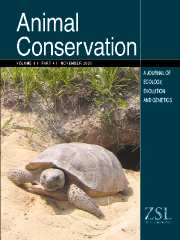Crossref Citations
This article has been cited by the following publications. This list is generated based on data provided by
Crossref.
Blumstein, Daniel T.
2002.
Moving to suburbia: ontogenetic and evolutionary consequences of life on predator‐free islands.
Journal of Biogeography,
Vol. 29,
Issue. 5-6,
p.
685.
Griffin, Andrea S
and
Evans, Christopher S
2003.
The role of differential reinforcement in predator avoidance learning.
Behavioural Processes,
Vol. 61,
Issue. 1-2,
p.
87.
Biebouw, K.
and
Blumstein, D.T.
2003.
Tammar wallabies (Macropus eugenii) associate safety with higher levels of nocturnal illumination.
Ethology Ecology & Evolution,
Vol. 15,
Issue. 2,
p.
159.
Wroe, Stephen
Field, Judith
Fullagar, Richard
and
Jermin, Lars S.
2004.
Megafaunal extinction in the late Quaternary and the global overkill hypothesis.
Alcheringa: An Australasian Journal of Palaeontology,
Vol. 28,
Issue. 1,
p.
291.
Darwish, Tamara L.
Mirza, Reehan S.
Leduc, Antoine O.H.C.
and
Brown, Grant E.
2005.
Acquired recognition of novel predator odour cocktails by juvenile glowlight tetras.
Animal Behaviour,
Vol. 70,
Issue. 1,
p.
83.
WHILE, GEOFFREY M.
and
MCARTHUR, CLARE
2005.
Foraging in a risky environment: a comparison of Bennett's wallabies Macropus rufogriseus rufogriseus (Marsupialia: Macropodidae) and red‐bellied pademelons Thylogale billiardierii (Marsupialia: Macropodidae) in open habitats.
Austral Ecology,
Vol. 30,
Issue. 7,
p.
756.
Apfelbach, Raimund
Blanchard, Caroline D.
Blanchard, Robert J.
Hayes, R. Andrew
and
McGregor, Iain S.
2005.
The effects of predator odors in mammalian prey species: A review of field and laboratory studies.
Neuroscience & Biobehavioral Reviews,
Vol. 29,
Issue. 8,
p.
1123.
Ramp, Daniel
Russell, Ben G.
and
Croft, David B.
2005.
Predator scent induces differing responses in two sympatric macropodids.
Australian Journal of Zoology,
Vol. 53,
Issue. 2,
p.
73.
Monclús, Raquel
Rödel, Heiko G.
Von Holst, Dietrich
and
De Miguel, Javier
2005.
Behavioural and physiological responses of naïve European rabbits to predator odour.
Animal Behaviour,
Vol. 70,
Issue. 4,
p.
753.
2006.
Verhaltensbiologie.
p.
185.
Monclús, Raquel
Rödel, Heiko G.
and
Von Holst, Dietrich
2006.
Fox Odour Increases Vigilance in European Rabbits: A Study under Semi‐Natural Conditions.
Ethology,
Vol. 112,
Issue. 12,
p.
1186.
Hayes, R.A.
Nahrung, H.F.
and
Wilson, J.C.
2006.
The response of native Australian rodents to predator odours varies seasonally: a by-product of life history variation?.
Animal Behaviour,
Vol. 71,
Issue. 6,
p.
1307.
Stankowich, Theodore
and
Coss, Richard G
2007.
The re-emergence of felid camouflage with the decay of predator recognition in deer under relaxed selection.
Proceedings of the Royal Society B: Biological Sciences,
Vol. 274,
Issue. 1607,
p.
175.
ATWOOD, TODD C.
GESE, ERIC M.
and
KUNKEL, KYRAN E.
2007.
Comparative Patterns of Predation by Cougars and Recolonizing Wolves in Montana's Madison Range.
The Journal of Wildlife Management,
Vol. 71,
Issue. 4,
p.
1098.
Cox, Jonathan G.
and
Lima, Steven L.
2007.
Response to Banks and Dickman: prey naiveté does indeed need more attention.
Trends in Ecology & Evolution,
Vol. 22,
Issue. 5,
p.
230.
Hollén, Linda I.
and
Manser, Marta B.
2007.
Persistence of Alarm‐Call Behaviour in the Absence of Predators: A Comparison Between Wild and Captive‐Born Meerkats (Suricata Suricatta).
Ethology,
Vol. 113,
Issue. 11,
p.
1038.
BERGER, JOEL
2007.
Carnivore Repatriation and Holarctic Prey: Narrowing the Deficit in Ecological Effectiveness.
Conservation Biology,
Vol. 21,
Issue. 4,
p.
1105.
Blumstein, Daniel T.
Barrow, Lisa
and
Luterra, Markael
2008.
Olfactory Predator Discrimination in Yellow‐Bellied Marmots.
Ethology,
Vol. 114,
Issue. 11,
p.
1135.
MCEVOY, JOANNE
SINN, DAVID L.
and
WAPSTRA, ERIK
2008.
Know thy enemy: Behavioural response of a native mammal (Rattus lutreolus velutinus) to predators of different coexistence histories.
Austral Ecology,
Vol. 33,
Issue. 7,
p.
922.
Grey-Ross, Rebecca
Downs, Colleen T.
and
Kirkman, Kevin
2009.
Using housing estates as conservation tools: A case study in KwaZulu-Natal, South Africa.
Applied Geography,
Vol. 29,
Issue. 3,
p.
371.


